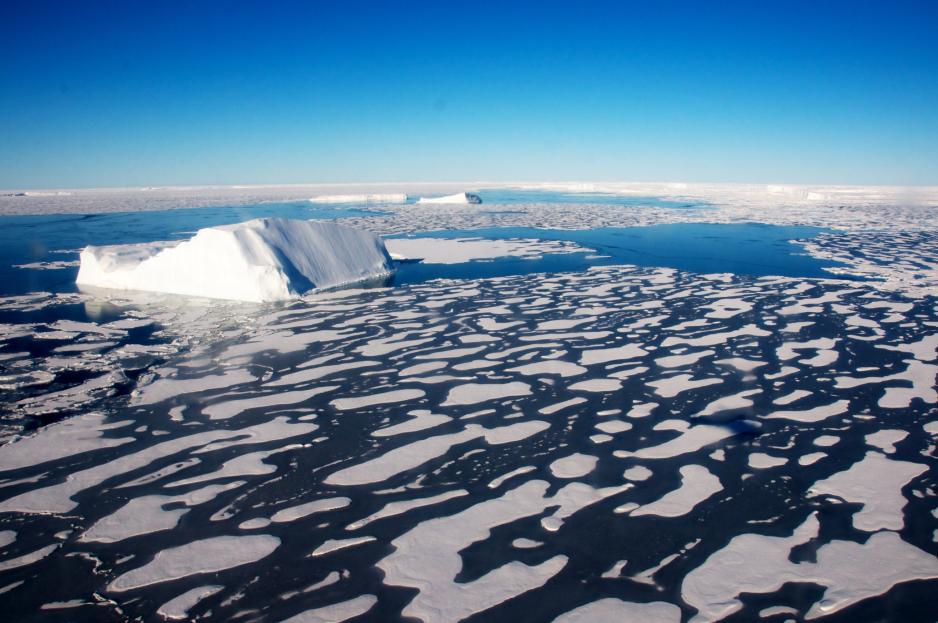Op-ed: Whispers in the Wind: Aerosols as the Arctic’s Urgent, Unseen Ally

"Even small deposits of soot on snow can amplify regional warming up to three times faster than the global average, making Arctic surfaces highly sensitive to human emissions thousands of kilometers away," writes researcher Hassan Alzain in this op-ed. (Archive photo of the Fram Strait: Fruchtzwerg World under CC BY-NC-ND 2.0)
Op-ed: Aerosols are reshaping the Arctic in ways that greenhouse gases alone cannot explain. A dedicated management program could turn this hidden climate driver into a lever for immediate action, writes Hassan Alzain.
This is an op-ed written by an external contributor. All views expressed are the author's own.
In the Arctic’s mirror of ice and snow, invisible specks are etching changes that no gas alone can account for. Riding winds from distant wildfires, ship exhausts, gas flares, dust storms, and volcanic plumes, these particles settle on bright surfaces and seed clouds, shifting the region’s energy balance on the scale of days and weeks.
A targeted strategy for these airborne particles could unlock swift climate gains for communities and ecosystems, without closing sea lanes or halting development. It is a practical complement to long-term decarbonization that the High North can lead, measure, and prove.
This call for urgent, short-term action resonates strongly with the spirit of the International Day of Climate Action 2025 on October 24, a moment when the world mobilizes for collective solutions. Scientists now estimate that human-made aerosols currently offset nearly half a degree of global warming, showing how powerful these short-lived particles are in shaping regional temperatures.
The Arctic’s Fragile Mirror
In global climate debates, long-lived gases like carbon dioxide and methane command most attention. Yet aerosols are reshaping the High North on short timescales that policy can reach.
New modelling in Atmospheric Chemistry and Physics shows that depositing 50 nanograms of black carbon per gram of snow in Arctic Spring produces a daily average radiative forcing of about 1.6 watts per square meter in offline runs and about 1.4 watts per square meter when surface feedbacks are included, enough to reduce snow reflectivity and hasten melt.
Aerosols are reshaping the High North on short timescales that policy can reach.
Long-term observations in the Western Siberian Arctic point to winter peaks tied to gas flaring and to episodic enhancements from transported wildfire smoke, underscoring how local activity and long-range plumes combine seasonally.
Even small deposits of soot on snow can amplify regional warming up to three times faster than the global average, making Arctic surfaces highly sensitive to human emissions thousands of kilometers away.
The cryosphere is responding. On 27 March 2025, Arctic Sea ice reached a record low winter maximum of 14.33 million square kilometers, the lowest value in the 47-year satellite era according to the National Snow and Ice Data Center.
Aerosols do not fully explain this trajectory, but by darkening snow and altering cloud properties, they influence both the pace and geography of the retreat. Framing these realities during the International Day of Climate Action can help link Arctic evidence to global urgency, showing how near-term interventions complement broader decarbonization goals.
The sharp decline in reflective particles from cleaner fuels and reduced flaring is already exposing more solar energy to the Arctic surface, accelerating melt cycles even as overall air quality improves.
Even small deposits of soot on snow can amplify regional warming.
Particles That Punch Above Their Weight
The Arctic’s bright surface amplifies the impact of even thin layers of dark material. When soot or dust settles, more sunlight is absorbed, melt accelerates, and darker ocean or land is exposed, which absorbs even more energy.
In regions with deep, long-lasting spring snowpacks, such as parts of Greenland and eastern Siberia, these effects persist as sunlight returns, magnifying seasonal melt.
Western Siberian measurements show the strongest signals when nearby activity elevates winter burdens and when circulation imports smoke from lower latitudes. Seasonal spikes in black carbon can change local snow reflectivity by up to 10 percent, a shift large enough to alter ice thickness and influence global sea-level trends.
Cloud interactions add a second pathway. Observation-constrained analysis indicates that the effective radiative forcing from aerosol cloud interactions is smaller than older model estimates, though uncertainties remain large in polar conditions with mixed-phase clouds and low sun angles.
Advances in modelling of brown carbon suggest a small but positive global mean top of atmosphere radiative effect of about 0.04 watts per square meter, with larger regional effects during intense biomass burning that can extend into the Arctic.
Wildfire smoke mapping now provides a clearer baseline for management. A high-resolution global dataset in Earth System Science Data quantifies fire-sourced PM2.5 at quarter-degree spatial resolution with daily data, from 2000 through 2023, enabling consistent assessments of smoke exposure and transport into polar regions without relying on single-country case studies.
The rise in Arctic wildfire activity means that soot emissions could soon rival shipping as the dominant regional warming driver if left unmanaged.
The Arctic’s bright surface amplifies the impact of even thin layers of dark material.
The International Day of Climate Action is not just symbolic but an organizing point for such science-policy linkages: turning datasets and Arctic observations into pressure for concrete steps like cleaner fuels, flaring management, and fire prevention.
Blueprint for an Arctic Aerosol Arsenal
A credible program rests on vigilant monitoring, sharpened simulations, and pragmatic policy. On monitoring, the Copernicus Sentinel 5P mission routinely provides aerosol products such as absorbing aerosol index and aerosol layer height, and recent processor upgrades have improved retrieval quality and access.
Paired with expanded Arctic ground stations and targeted airborne campaigns, these data can enable near-real-time tracking of plumes, deposition, and resulting snow darkening.
On modelling, polar-specific physics matters. The same Atmospheric Chemistry and Physics study that quantified the 50 nanograms per gram threshold shows that ignoring snowpack feedbacks can overstate snow darkening impacts by more than 50 percent, a gap large enough to mislead planning if not corrected.
Models that integrate snow chemistry, cloud microphysics, and ice-ocean coupling can rank interventions by season and place, from cleaner marine fuels and particulate control to improved flaring management and wildfire risk reduction.
On policy, tools already exist. The International Maritime Organization’s prohibition on the use and carriage for use as fuel of heavy fuel oil in Arctic waters took effect on 1 July 2024, with exemptions and waivers that can extend to 1 July 2029, depending on vessel and flag state.
Evidence from the International Council on Clean Transportation indicates that switching from residual to distillate fuels can reduce ship black carbon by 50 to 80 percent, and adding diesel particulate filters raises the total reduction, with an estimated 115 to 183 tonnes avoided from fuel switching and up to 206 tonnes annually when filters are included for EU-regulated ships of at least 5,000 gross tonnage operating in the Geographic Arctic.
These measures are compatible with safe navigation and ongoing economic activity and can deliver measurable results quickly. When combined with enhanced flaring controls, these actions could minimize Arctic black carbon by nearly half within this decade, producing visible gains in sea-ice reflectivity and melt stabilization.
The International Day of Climate Action is not just symbolic.
As Graeme Mitchell, award-winning environmental health educator at Liverpool John Moores University, notes: “The Arctic shows how subtle chemical shifts cascade through global cycles. Managing these changes is not just about measuring particles, but about building governance that can adapt as quickly as the Earth responds.”
Horizons of Haze and Hope
Attribution remains complex because Arctic aerosol loads blend local emissions with long-range transport. That argues for cooperation that reaches beyond the Arctic Council and for transparent data sharing across jurisdictions.
The good news is that aerosol lifetimes are short, so targeted reductions show benefits within seasons, a cadence that aligns with shipping schedules, flare management, and fire seasons.
Shipping trends underscore both the challenge and the opportunity. The Arctic Council’s Protection of the Arctic Marine Environment working group reports that distance sailed in the Polar Code area increased 108%, from 6.1 million nautical miles in 2013 to 12.7 million in 2024, with 1,781 unique vessels operating in 2024.
Managing shipping-related black carbon on this trajectory is less about curbing activity and more about accelerating cleaner fuels and filters that preserve reliability while cutting soot.
The Intergovernmental Panel on Climate Change is in its seventh assessment cycle. Member governments have agreed that Working Group I will assess the physical science basis, including short-lived climate forcers such as aerosols, with major reports scheduled during the cycle and a synthesis report by late 2029.
An Arctic Aerosols Management Program can feed real-world data streams, intervention trials, and governance lessons into the AR7 process, shaping how short-lived particles are represented in global assessments and how near-term adaptation and mitigation pathways incorporate these fast-acting levers.
As the world marks the International Day of Climate Action on October 24, the Arctic offers a timely testbed. Managing aerosols here can show how rapid, targeted action delivers measurable benefits within seasons, a living example of what climate action must look like when urgency meets opportunity.
In practical terms, this means the Arctic could demonstrate the first measurable seasonal cooling effect ever achieved through targeted pollution control, proving that immediate action, grounded in science, can bend the curve of warming within a single year.


